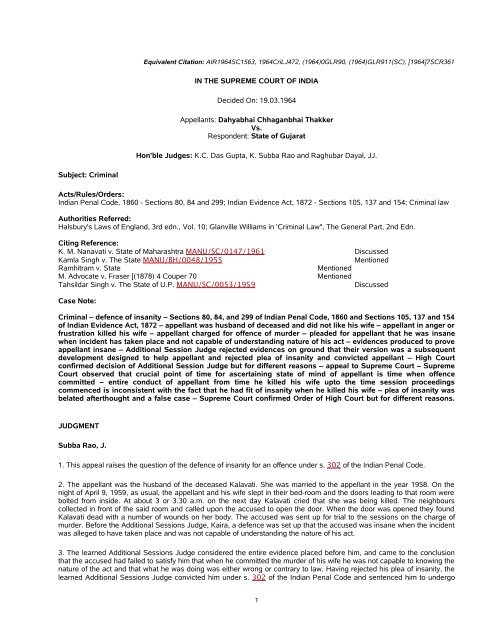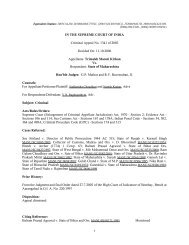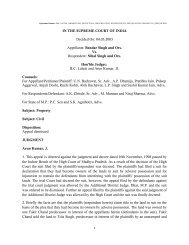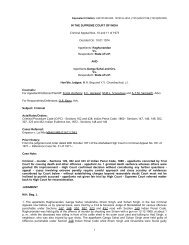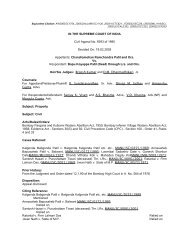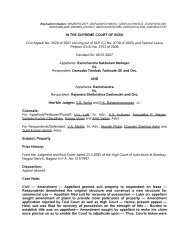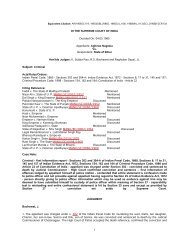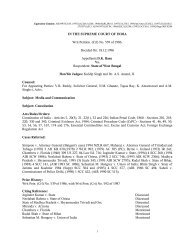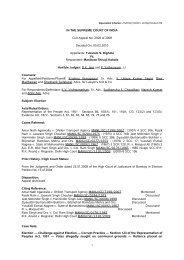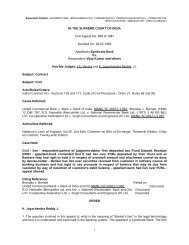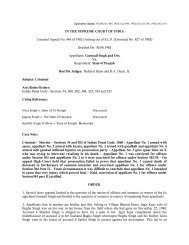Dahyabhai Chhaganbhai Thakker Vs. Respondent: State of Gujarat
Dahyabhai Chhaganbhai Thakker Vs. Respondent: State of Gujarat
Dahyabhai Chhaganbhai Thakker Vs. Respondent: State of Gujarat
Create successful ePaper yourself
Turn your PDF publications into a flip-book with our unique Google optimized e-Paper software.
Equivalent Citation: AIR1964SC1563, 1964CriLJ472, (1964)0GLR90, (1964)GLR911(SC), [1964]7SCR361IN THE SUPREME COURT OF INDIADecided On: 19.03.1964Appellants: <strong>Dahyabhai</strong> <strong>Chhaganbhai</strong> <strong>Thakker</strong><strong>Vs</strong>.<strong>Respondent</strong>: <strong>State</strong> <strong>of</strong> <strong>Gujarat</strong>Hon'ble Judges: K.C. Das Gupta, K. Subba Rao and Raghubar Dayal, JJ.Subject: CriminalActs/Rules/Orders:Indian Penal Code, 1860 - Sections 80, 84 and 299; Indian Evidence Act, 1872 - Sections 105, 137 and 154; Criminal lawAuthorities Referred:Halsbury's Laws <strong>of</strong> England, 3rd edn., Vol. 10; Glanville Williams in 'Criminal Law", The General Part, 2nd Edn.Citing Reference:K. M. Nanavati v. <strong>State</strong> <strong>of</strong> Maharashtra MANU/SC/0147/1961 DiscussedKamla Singh v. The <strong>State</strong> MANU/BH/0048/1955MentionedRamhitram v. <strong>State</strong>MentionedM. Advocate v. Fraser [(1878) 4 Couper 70 MentionedTahsildar Singh v. The <strong>State</strong> <strong>of</strong> U.P. MANU/SC/0053/1959DiscussedCase Note:Criminal – defence <strong>of</strong> insanity – Sections 80, 84, and 299 <strong>of</strong> Indian Penal Code, 1860 and Sections 105, 137 and 154<strong>of</strong> Indian Evidence Act, 1872 – appellant was husband <strong>of</strong> deceased and did not like his wife – appellant in anger orfrustration killed his wife – appellant charged for <strong>of</strong>fence <strong>of</strong> murder – pleaded for appellant that he was insanewhen incident has taken place and not capable <strong>of</strong> understanding nature <strong>of</strong> his act – evidences produced to proveappellant insane – Additional Session Judge rejected evidences on ground that their version was a subsequentdevelopment designed to help appellant and rejected plea <strong>of</strong> insanity and convicted appellant – High Courtconfirmed decision <strong>of</strong> Additional Session Judge but for different reasons – appeal to Supreme Court – SupremeCourt observed that crucial point <strong>of</strong> time for ascertaining state <strong>of</strong> mind <strong>of</strong> appellant is time when <strong>of</strong>fencecommitted – entire conduct <strong>of</strong> appellant from time he killed his wife upto the time session proceedingscommenced is inconsistent with the fact that he had fit <strong>of</strong> insanity when he killed his wife – plea <strong>of</strong> insanity wasbelated afterthought and a false case – Supreme Court confirmed Order <strong>of</strong> High Court but for different reasons.JUDGMENTSubba Rao, J.1. This appeal raises the question <strong>of</strong> the defence <strong>of</strong> insanity for an <strong>of</strong>fence under s. 302 <strong>of</strong> the Indian Penal Code.2. The appellant was the husband <strong>of</strong> the deceased Kalavati. She was married to the appellant in the year 1958. On thenight <strong>of</strong> April 9, 1959, as usual, the appellant and his wife slept in their bed-room and the doors leading to that room werebolted from inside. At about 3 or 3.30 a.m. on the next day Kalavati cried that she was being killed. The neighbourscollected in front <strong>of</strong> the said room and called upon the accused to open the door. When the door was opened they foundKalavati dead with a number <strong>of</strong> wounds on her body. The accused was sent up for trial to the sessions on the charge <strong>of</strong>murder. Before the Additional Sessions Judge, Kaira, a defence was set up that the accused was insane when the incidentwas alleged to have taken place and was not capable <strong>of</strong> understanding the nature <strong>of</strong> his act.3. The learned Additional Sessions Judge considered the entire evidence placed before him, and came to the conclusionthat the accused had failed to satisfy him that when he committed the murder <strong>of</strong> his wife he was not capable to knowing thenature <strong>of</strong> the act and that what he was doing was either wrong or contrary to law. Having rejected his plea <strong>of</strong> insanity, thelearned Additional Sessions Judge convicted him under s. 302 <strong>of</strong> the Indian Penal Code and sentenced him to undergo1
igorous imprisonment for life. On appeal the High Court agreed with that finding, though for different reasons, andconfirmed the conviction and sentence <strong>of</strong> the accused. Hence the present appeal.4. Learned counsel for the appellant contended that the High Court, having believed the evidence <strong>of</strong> the prosecutionwitnesses, should have held that the accused had discharged the burden placed on him <strong>of</strong> proving that at the time he killedhis wife he was incapable <strong>of</strong> knowing the nature <strong>of</strong> his act or what he was doing was either wrong or contrary to law. Hefurther contended that even if he had failed to establish that fact conclusively, the evidence adduced was such as to raise areasonable doubt in the mind <strong>of</strong> the Judge as regards one <strong>of</strong> the ingredients <strong>of</strong> the <strong>of</strong>fence, namely, criminal intention, and,therefore, the court should have acquitted him for the reason that the prosecution had not proved the case beyondreasonable doubt.5. Before we address ourselves to the facts <strong>of</strong> the case and the findings arrived at by the High Court, it would beconvenient to notice the relevant aspects <strong>of</strong> the law <strong>of</strong> the plea <strong>of</strong> insanity. At the outset let us consider the materialprovisions without reference to decided cases. The said provisions are :INDIAN PENAL CODESection 299 - Whoever causes death by doing an act with the intention <strong>of</strong> causing death, or with the intention <strong>of</strong> causingsuch bodily injury as is likely to cause death, or with the knowledge that he is likely by such act to cause death, commitsthe <strong>of</strong>fence <strong>of</strong> culpable homicide.Section 84 - Nothing is an <strong>of</strong>fence which is done by a person who, at the time <strong>of</strong> doing it, by reason <strong>of</strong> unsoundness <strong>of</strong>mind, is incapable <strong>of</strong> knowing the nature <strong>of</strong> the act, or that he is doing what is either wrong or contrary to law.INDIAN EVIDENCE ACTSection 105 - When a persons is accused <strong>of</strong> any <strong>of</strong>fence, the burden <strong>of</strong> proving the existence <strong>of</strong> circumstances bringingthe case within any <strong>of</strong> the General Exceptions in the Indian Penal Code (XLV <strong>of</strong> 1860) or within any special exception orproviso contained in any other part <strong>of</strong> the same Code, or in any law defining the <strong>of</strong>fence, is upon him, and the Court shallpresume the absence <strong>of</strong> such circumstances.Section 4 - "Shall presume" : Whenever it is directed by this Act that the Court shall presume a fact, it shall regard suchfacts as proved unless and until it is disproved."Proved" - A fact is said to be "proved" when after considering the matters before it, the Court either believes it to exist, orconsiders its existence so probable that a prudent man ought, under the circumstances <strong>of</strong> the particular case, to act uponthe supposition that it exists."Disproved" - A fact is said to be disproved when, after considering the matters before it, the Court either believes that itdoes not exist, or considers its non-existence so probable that a prudent man ought, under the circumstances <strong>of</strong> theparticular case, to act upon the supposition that it does not exist.Section 101 - Whoever desires any Court to give judgment as to any legal right or liability dependent on the existence <strong>of</strong>fact which he asserts, must prove that those facts exist.6. When a person is bound to prove the existence <strong>of</strong> any fact, it is said that the burden <strong>of</strong> pro<strong>of</strong> lies on that person.7. It is a fundamental principle <strong>of</strong> criminal jurisprudence that an accused is presumed to be innocent and, therefore, theburden lies on the prosecution to prove the guilt <strong>of</strong> the accused beyond reasonable doubt. The prosecution, therefore, in acase <strong>of</strong> homicide shall prove beyond reasonable doubt that the accused caused death with the requisite intentiondescribed in s. 299 <strong>of</strong> the Indian Penal Code. This general burden never shifts and it always rests on the prosecution. But,as s. 84 <strong>of</strong> the Indian Penal Code provides that nothing is an <strong>of</strong>fence if the accused at the time <strong>of</strong> doing that act, by reason<strong>of</strong> unsoundness <strong>of</strong> mind was incapable <strong>of</strong> knowing the nature <strong>of</strong> his act or what he was doing was either wrong or contraryto law. This being in exception, under s. 105 <strong>of</strong> the Evidence Act the burden <strong>of</strong> proving the existence <strong>of</strong> circumstancesbringing the case within the said exception lies on the accused; and the court shall presume the absence <strong>of</strong> suchcircumstances. Under s. 105 <strong>of</strong> the Evidence Act, read with the definition <strong>of</strong> "shall presume" in s. 4 there<strong>of</strong>, the court shallregard the absence <strong>of</strong> such circumstances as proved unless, after considering the matters before it, it believes that saidcircumstances existed or their existence was so probable that a prudent man ought, under the circumstances <strong>of</strong> theparticular case, to act upon the supposition that they did exist. To put it in other words, the accused will have to rebut the2
presumption that such circumstances did not exist, by placing material before the court sufficient to make it consider theexistence <strong>of</strong> the said circumstances so probable that a prudent man would act upon them. The accused has to satisfy thestandard <strong>of</strong> a "prudent man". If the material placed before the court, such as, oral and documentary evidence,presumptions, admissions or even the prosecution evidence, satisfies the test <strong>of</strong> "prudent man", the accused will havedischarged his burden. The evidence so placed may not be sufficient to discharge the burden under s. 105 <strong>of</strong> the EvidenceAct, but it may raise a reasonable doubt in the mind <strong>of</strong> a judge as regards one or other <strong>of</strong> the necessary ingredients <strong>of</strong> the<strong>of</strong>fence itself. It may, for instance, raise a reasonable doubt in the mind <strong>of</strong> the judge whether the accused had the requisiteintention laid down in s. 299 <strong>of</strong> the Indian Penal Code. If the judge has such reasonable doubt, he has to acquit theaccused, for in that even the prosecution will have failed to prove conclusively the guilt <strong>of</strong> the accused. There is no conflictbetween the general burden, which is always on the prosecution and which never shifts, and the special burden that restson the accused to make out his defence <strong>of</strong> insanity.8. The textbooks placed before us and the decisions cited at the Bar lead to the same conclusion. In Halsbury's Laws <strong>of</strong>England, 3rd edn., Vol. 10, at p. 288, it is stated thus :"The onus <strong>of</strong> establishing insanity is on the accused. The burden <strong>of</strong> pro<strong>of</strong> upon him is no higher than which rests upon aparty to civil proceedings."9. Glanville Williams in his book 'Criminal Law", The General Part, 2nd Edn., placed the relevant aspect in the correctperspective thus, at p. 516 :"As stated before, to find that the accused did not know the nature and quality <strong>of</strong> his act is, in part, only another way <strong>of</strong>finding that he was ignorant as to some fact constituting an ingredient <strong>of</strong> the crime; and if the crime is one requiringintention or recklessness he must, on the view advanced in this book, be innocent <strong>of</strong> mens rea. Since the persuasiveburden <strong>of</strong> pro<strong>of</strong> <strong>of</strong> mens rea is on the prosecution, on question <strong>of</strong> defence, or <strong>of</strong> disease <strong>of</strong> the mind, arises, except in s<strong>of</strong>ar as the prisoner is called upon for his own safety to neutralise the evidence <strong>of</strong> the prosecution. No persuasive burden <strong>of</strong>pro<strong>of</strong> rests on him, and if the jury are uncertain whether the allegation <strong>of</strong> mens rea is made out................the benefit <strong>of</strong> thedoubt must be given to the prisoner, for, in the words <strong>of</strong> Lord Reading in another context, "the Crown would then havefailed to discharge the burden imposed on it by our law <strong>of</strong> satisfying the jury beyond reasonable doubt <strong>of</strong> the guilt <strong>of</strong> theprisoner."10. This Court in K. M. Nanavati v. <strong>State</strong> <strong>of</strong> Maharashtra [1962] Supp. 1 S.C.R. 567 had to consider the question <strong>of</strong> burden<strong>of</strong> pro<strong>of</strong> in the context <strong>of</strong> a defence based on the exception embodied in s. 80 <strong>of</strong> the Indian Penal Code. In that context thelaw is summarized thus :"The alleged conflict between the general burden which lies on the prosecution and the special burden imposed on theaccused under s. 105 <strong>of</strong> the Evidence Act is more imaginary than real. Indeed, there is no conflict at all. There may arisethree different situations : (1) A statute may throw the burden <strong>of</strong> pro<strong>of</strong> <strong>of</strong> all or some <strong>of</strong> the ingredients <strong>of</strong> an <strong>of</strong>fence on theaccused : (see ss. 4 and 5 <strong>of</strong> the Prevention <strong>of</strong> Corruption Act). (2) The special burden may not touch the ingredients <strong>of</strong> the<strong>of</strong>fence, but only the protection given on the assumption <strong>of</strong> the pro<strong>of</strong> <strong>of</strong> the said ingredients : (see ss. 77, 78, 79, 81 and88 <strong>of</strong> the Indian Penal Code). (3) It may relate to an exception, some <strong>of</strong> the many circumstances required to attract theexception, if proved, affecting the pro<strong>of</strong> <strong>of</strong> all or some <strong>of</strong> the ingredients <strong>of</strong> the <strong>of</strong>fence : (see s. 80 <strong>of</strong> the Indian PenalCode)........... In the third case, though the burden lies on the accused to bring his case within the exception the factsproved may not discharge the said burden, but may affect the pro<strong>of</strong> <strong>of</strong> the ingredients <strong>of</strong> the <strong>of</strong>fence."11. After giving an illustration, this Court proceeded to state :"That evidence may not be sufficient to prove all the ingredients <strong>of</strong> s. 80 <strong>of</strong> the Indian Penal Code, but may prove that theshooting was by accident or inadvertence, i.e., it was done without any intention or requisite state <strong>of</strong> mind, which is theessence <strong>of</strong> the <strong>of</strong>fence, within the meaning <strong>of</strong> s. 300, Indian Penal Code, or at any rate may throw a reasonable doubt onthe essential ingredients <strong>of</strong> the <strong>of</strong>fence <strong>of</strong> murder.......... In this view it might be said that the general burden to prove theingredients <strong>of</strong> the <strong>of</strong>fence, unless there is a specific statute to the contrary, is always on the prosecution, but the burden toprove the circumstances coming under the exceptions lies upon the accused."12. What is said <strong>of</strong> s. 80 <strong>of</strong> the Indian Penal Code will equally apply to s. 84 there<strong>of</strong>. A Division Bench <strong>of</strong> the Patna HighCourt in Kamla Singh v. The <strong>State</strong> MANU/BH/0048/1955 : AIR1955Pat209 invoked the same principle when the plea <strong>of</strong>insanity was raised. A Division Bench <strong>of</strong> the Nagpur High Court in Ramhitram v. <strong>State</strong> A.I.R. 1956 Nag. 187 has struck adifferent note inasmuch as it held that the benefit <strong>of</strong> doubt which the law gives on the presumption <strong>of</strong> innocence is availableonly where the prosecution had not been able to connect the accused with the occurrence and that it had nothing to dowith the mental state <strong>of</strong> the accused. With great respect, we cannot agree with this view. If this view were correct, the court3
would be helpless and would be legally bound to convict an accused even though there was genuine and reasonable doubtin its mind that the accused had not the requisite intention when he did the act for which he was charged. This view is alsoinconsistent with that expressed in Nanavati's case [1962] Supp. 1 S.C.R. 567. A Scottish case, H.M. Advocate v. Fraser(1878) 4 Couper 70, noticed in Glanville Williams' "Criminal Law", The General Part, 2nd Edn., at p. 517, pinpoints thedistinction between these two categories <strong>of</strong> burden <strong>of</strong> pro<strong>of</strong>. There, a man killed his baby while he was asleep: he wasdreaming that he was struggling with a wild beast. The learned author elaborates the problem thus :"When the Crown proved that the accused had killed his baby what may be called an evidential presumption orpresumption <strong>of</strong> fact arose that the killing was murder. Had no evidence been adduced for the defence the jury could haveconvicted <strong>of</strong> murder, and their verdict would have been upheld on appeal. The burden <strong>of</strong> adducing evidence <strong>of</strong> the delusiontherefore lay on the accused. Suppose that, when all the evidence was in, the jury did not know what to make <strong>of</strong> the matter.They might suspect the accused to be inventing a tale to cover his guilt, and yet not be reasonably certain about it. It thatevent the accused would be entitled to an acquittal. The prosecution must prove beyond reasonable doubt not only theactus reus but the mens rea."13. The doctrine <strong>of</strong> burden <strong>of</strong> pro<strong>of</strong> in the context <strong>of</strong> the plea <strong>of</strong> insanity may be stated in the following propositions : (1)The prosecution must prove beyond reasonable doubt that the accused had committed the <strong>of</strong>fence with the requisite mensrea; and the burden <strong>of</strong> proving that always rests on the prosecution from the beginning to the end <strong>of</strong> the trial. (2) There is arebuttable presumption that the accused was not insane, when he committed the crime, in the sense laid down by s. 84 <strong>of</strong>the Indian Penal Code : the accused may rebut it by placing before the court all the relevant evidence - oral, documentaryor circumstantial, but the burden <strong>of</strong> pro<strong>of</strong> upon him is no higher than that rests upon a party to civil proceedings. (3) Even ifthe accused was not able to establish conclusively that he was insane at the time he committed the <strong>of</strong>fence, the evidenceplaced before the court by the accused or by the prosecution may raise a reasonable doubt in the mind <strong>of</strong> the court asregards one or more <strong>of</strong> the ingredients <strong>of</strong> the <strong>of</strong>fence, including mens rea <strong>of</strong> the accused and in that case the court wouldbe entitled to acquit the accused on the ground that the general burden <strong>of</strong> pro<strong>of</strong> resting on the prosecution was notdischarged.14. Now we come to the merits <strong>of</strong> the case. Ordinarily this Court in exercise <strong>of</strong> its jurisdiction under Art. 136 <strong>of</strong> theConstitution accepts the findings <strong>of</strong> fact arrived at by the High Court. But, after having gone through the judgments <strong>of</strong> thelearned Additional Sessions Judge and the High Court, we are satisfied that this is an exceptional case to depart from thesaid practice. The learned Additional Sessions Judge rejected the evidence <strong>of</strong> the prosecution witnesses on the groundthat their version was a subsequent development designed to help the accused. The learned Judges <strong>of</strong> the High Courtaccepted their evidence for two different reasons. Raju, J., held that a court can permit a party calling a witness to putquestions under s. 154 <strong>of</strong> the Evidence Act only in the examination-in-chief <strong>of</strong> the witness; for this conclusion, he hasgiven the following two reasons : (1) the wording <strong>of</strong> ss. 137 and 154 <strong>of</strong> the Evidence Act indicates it, and (2) if he ispermitted to put questions in the nature <strong>of</strong> cross-examination at the stage <strong>of</strong> re-examination by the adverse party, theadverse party will have no chance <strong>of</strong> cross-examination the witness with reference to the answers given to the saidquestions. Neither <strong>of</strong> the two reasons, in our view, is tenable. Section 137 <strong>of</strong> the Evidence Act gives only the three stagesin the examination <strong>of</strong> a witness, namely, examination-in-chief, cross-examination and re-examination. This is a routinesequence in the examination <strong>of</strong> a witness. This has no relevance to the question when a party calling a witness can bepermitted to put to him questions under s. 154 <strong>of</strong> the Evidence Act : that is governed by the provisions <strong>of</strong> s. 154 <strong>of</strong> the saidAct, which confers a discretionary power on the court to permit a person who calls a witness to put any questions to himwhich might be put in cross-examination by the adverse party. Section 154 does not in terms, or by necessary implicationconfine the exercise <strong>of</strong> the power by the court before the examination-in-chief is concluded or to any particular stage <strong>of</strong> theexamination <strong>of</strong> the witness. It is wide in scope and the discretion is entirely left to the court to exercise the power when thecircumstances demand. To confine this power to the stage <strong>of</strong> examination-in-chief is to make in ineffective in practice. Aclever witness in his examination-in-chief faithfully conforms to what he stated earlier to the police or in the committingcourt, but in the cross-examination introduces statements in a subtle way contradicting in effect what he stated in theexamination-in-chief. If his design is obvious, we do not see why the court cannot, during the course <strong>of</strong> his crossexamination,permit the person calling him as a witness to put questions to him which might be put in cross-examination bythe adverse party. To confine the operation <strong>of</strong> s. 54 <strong>of</strong> the Evidence Act to a particular stage in the examination <strong>of</strong> awitness is to read words in the section which are not there. We cannot also agree with the High Court that if a party callinga witness is permitted to put such questions to the witness after he has been cross-examined by the adverse party, theadverse party will not have any opportunity to further cross-examine the witness on the answers elicited by putting suchquestions. In such an event the court certainly, in exercise <strong>of</strong> its discretion, will permit the adverse party to cross-examinethe witness on the answers elicited by such questions. The court, therefore, can permit a person, who calls a witness, toput questions to him which might be put in the cross-examination at any stage <strong>of</strong> the examination <strong>of</strong> the witness, provided ittakes care to give an opportunity to the accused to cross-examine him on the answers elicited which do not find place inthe examination-in-chief. In the present case what happened was that some <strong>of</strong> the witnesses faithfully repeated what theyhad stated before the police in the examination-in-chief, but in the cross-examination they came out with the story <strong>of</strong>insanity <strong>of</strong> the accused. The court, at the request <strong>of</strong> the Advocate for the prosecution, permitted him to cross-examine thesaid witnesses. It is not suggested that the Advocate appearing for the accused asked for a further opportunity to cross-4
examine the witnesses and was denied <strong>of</strong> it by the court. The procedure followed by the learned Judge does not conflictwith the express provisions <strong>of</strong> s. 154 <strong>of</strong> the Evidence Act. Mehta, J., accepted the evidence <strong>of</strong> the witnesses on the groundthat the earlier statements made by them before the police did not contradict their evidence in the court, as the nonmention<strong>of</strong> the mental state <strong>of</strong> the accused in the earlier statements was only an omission. This reason given by thelearned Judge is also not sound. This Court in Tahsildar Singh v. The <strong>State</strong> <strong>of</strong> U.P. [1959] Supp. 2 S.C.R. 875 laid downthe following test for ascertaining under what circumstances an alleged omission can be relied upon to contradict thepositive evidence in court :"................ (3) though a particular statement is not expressly recorded, a statement that can be deemed to be part <strong>of</strong> thatexpressly recorded can be used for contradiction, not because it is an omission strictly so-called but because it is deemedto form part <strong>of</strong> the recorded statement; (4) such a fiction is permissible by construction only in the following three cases : (i)when a recital is necessarily implied from the recital or recitals found in the statement.............; (ii) a negative aspect <strong>of</strong> apositive recital in a statement...............; and (iii) when the statement before the police and that before the Court cannotstand together................".15. Broadly stated, the position in the present case is that the witnesses in their statements before the police attributed aclear intention to the accused to commit murder, but before the court they stated that the accused was insane and,therefore, he committed the murder. In the circumstances it was necessarily implied in the previous statements <strong>of</strong> thewitnesses before the police that the accused was not insane at the time he committed the murder. In this view the previousstatements <strong>of</strong> the witnesses before the police can be used to contradict their version in the court. The judgment <strong>of</strong> the HighCourt, therefore, in relying upon some <strong>of</strong> the important prosecution witnesses was vitiated by the said errors <strong>of</strong> law. Wewould, therefore, proceed to consider the entire evidence for ourselves.16. When a plea <strong>of</strong> legal insanity is set up, the court has to consider whether at the time <strong>of</strong> commission <strong>of</strong> the <strong>of</strong>fence theaccused, by reason <strong>of</strong> unsoundness <strong>of</strong> mind, was incapable <strong>of</strong> knowing the nature <strong>of</strong> the act or that he was doing what waseither wrong or contrary to law. The crucial point <strong>of</strong> time for ascertaining the state <strong>of</strong> mind <strong>of</strong> the accused is the time whenthe <strong>of</strong>fence was committed. Whether the accused was in such a state <strong>of</strong> mind as to be entitled to the benefit <strong>of</strong> s. 84 <strong>of</strong> theIndian Penal Code can only be established from the circumstances which preceded, attended and followed the crime.17. The first question is, what is the motive for the appellant to kill his wife in the ghastly manner he did by inflicting 44 knifeinjuries on her body ? Natverlal Atmaram, the father <strong>of</strong> the deceased Kalavati, was examined as P.W. 13. He said thatabout 20 days before his daughter was murdered he received a letter from the accused asking him to take away hisdaughter on the ground that he did not like her, that he went to Bherai with that letter, showed it to <strong>Chhaganbhai</strong>, the father<strong>of</strong> the accused, and had a talk with him about it; that <strong>Chhaganbhai</strong> took that letter from him and promised to persuade theaccused not to discard his wife; that, after a week he again went to Bherai and asked the accused why he did not like thedeceased and the accused replied that he did not like her as she was not working properly; and that thereafter he wentback to his village and sent a message through someone that he would go to Bherai to take his daughter on Chaitra Sudi 1.The murder took place on the night before Chaitra Sudi 1. In the cross-examination he admitted that he did not tell thepolice that he had given the letter to the father <strong>of</strong> the accused, but he told the Sub-Inspector that he had shown the letter tohim. Chhaganlal, the father <strong>of</strong> the accused, as P.W. 7, no doubt denied that Natverlal gave him the letter written by theaccused, but the admitted that Natverlal came to his village 10 or 15 days before the incident to take his daughter away.The evidence <strong>of</strong> Natverlal that he went to the village <strong>of</strong> the accused is corroborated by the evidence <strong>of</strong> P.W. 7. It is,therefore, likely that the accused wrote a letter to Natverlal to take away Kalavati and it is also likely that Natverlal gave thatletter to P.W. 7 to persuade his son not to discard his wife. P.W.s 2 to 7 said in the cross-examination that the accused andhis wife were on cordial terms, but, as we will indicate later in our judgment, all these witnesses turned hostile in thesessions court and made a sustained attempt to support the case <strong>of</strong> insanity. That apart, their evidence does not disclosewhat opportunities they had to notice the cordial relation that existed between the accused and the deceased. The learnedAdditional Sessions Judge rightly disbelieved their evidence. The learned Additional Sessions Judge, who had seenNatverlal in the witness-box, has accepted his evidence. We, having gone through his evidence, see no reason to differfrom the opinion <strong>of</strong> the learned Additional Sessions Judge. It is also not denied that though the accused was in Ahmedabadfor ten months, he did not take his wife with him. We accept the evidence <strong>of</strong> Natverlal and hold that the accuse did not likehis wife and, therefore, wanted his father-in-law to take her away to his home and that his father-in-law promised to do sobefore Chaitra Sudi 1.18. The next question is, what was the previous history <strong>of</strong> the mental condition <strong>of</strong> the accused ? Here again, theprosecution witnesses, P.W.s. 2 to 7, deposed for the first time in the sessions court that 4 or 5 years before the incidentthe accused was getting fits <strong>of</strong> insanity. But all these witnesses stated before the police that the accused had committedthe murder <strong>of</strong> his wife, indicating thereby that he was sane at that time. Further, their evidence is inconsistent with the factsestablished in the case. During this period, it was admitted by P.W. 7, the accused was not treated by any doctor. Prior tothe incident he was serving in Ahmedabad in Monogram Mills for about a year and a half. Though the father <strong>of</strong> thedeceased was staying in a village only a few miles away from the village <strong>of</strong> the accused and though the betrothal was fixed5 years before the marriage, he did not know that the accused was insane, for if he had known that such was the mental5
condition <strong>of</strong> the accused he would not have given his daughter in marriage to him. It is impossible to conceive that hewould not have known that the accused was insane if he was really so, and particularly when it is the case <strong>of</strong> the accusedthat it was not kept secret but was well known to many people and to some <strong>of</strong> the witnesses, who came to depose for him.A month and a half prior to the incident Chhaganlal had gone to Ahmedabad for medical treatment and during that periodthe accused came from Ahmedabad to manage his father's shop in his absence. The fact that he was recalled fromAhmedabad was not disputed : but, while Natverlal said that the accused was recalled in order to manage Chhaganlal'sshop in his absence, Chhaganlal said that he was recalled because he was getting insane. The best evidence would havebeen that <strong>of</strong> the relative in whose house the accused was residing in Ahmedabad. But the relative was not examined. Itappears to us that the accused was serving in Ahmedabad in Monogram Mills and he was asked to come to the village <strong>of</strong>his father to attend to the letter's business a month and a half before the incident, as the father was leaving for Ahmedabadfor medical treatment. Before the commencement <strong>of</strong> the trial in the sessions court on June 27, 1959, an application wasfiled on behalf <strong>of</strong> the accused, supported by an affidavit field by the father <strong>of</strong> the accused, praying that, as the accused hadbecome insane, he should be sent for proper medical treatment and observation. In that affidavit it was not stated that theaccused was getting fits <strong>of</strong> insanity for the last 4 or 5 years and that he had one such fit at that time. If that was a fact, onewould expect the father to allege prominently the said fact in his affidavit. These facts lead to a reasonable inference thatthe case <strong>of</strong> the accused that he had periodical fits <strong>of</strong> insanity was an afterthought. The general statements <strong>of</strong> witnesses,P.W.s 1 to 6 that he had such fits must, therefore, necessarily be false. We, therefore, hold that the accused had noantecedent history <strong>of</strong> insanity.19. Now coming to the date when the incident took place, P.W. 7, the father <strong>of</strong> the accused, said that the accused wasinsane for 2 or 3 days prior to the incident. His evidence further discloses that he and his wife had gone to Ahmedabad onthe date <strong>of</strong> the incident and returned in the same evening. If really the accused had a fit <strong>of</strong> insanity a day or two before theincident, is it likely that both the parents would have left him and gone to Ahmedabad ? To get over this incongruity P.W. 7said that he went to Ahmedabad to see a bridegroom for his daughter and also to get medicine for the accused. But he didnot say which doctor he consulted and wherefrom he purchased the medicines or whether in fact he bought any medicinesat all. If the accused had a fit <strong>of</strong> insanity is it likely that the wife would have slept with him in the same room ? We must,therefore, hold that it had not been established that 2 or 3 days before the incident the accused had a fit <strong>of</strong> insanity.20. Now we come to the evidence <strong>of</strong> what happened on the night <strong>of</strong> the incident. Nobody except the accused knows whathappened in the bed-room. P.W.s 2 to 7 deposed that on the 10th April, 1959, corresponding to Chaitra Sudi 1, between 3and 4 a.m. they heard shouts <strong>of</strong> the deceased Kalavati to the effect that she was being killed; that they all went to the roombut found it locked from inside; that when the accused was asked to open the door, he said that he would open it only afterthe Mukhi (P.W. 1) was called; that after the Mukhi came there, the accused opened the door and came out <strong>of</strong> the roomwith a blood-stained knife in his hand; that the accused began talking irrelevantly and was speaking "why, you killed mymother ?" "why, you burnt my father's house ?"; that afterwards the accused sat down and threw dust and mud at thepersons gathered there; and that he was also laughing without any cause. In short, all the witnesses in one voicesuggested that the accused was under a hallucination that the deceased had murdered his mother and burnt his father'shouse and, therefore, he killed her in that state <strong>of</strong> mind without knowing what he was doing. But none <strong>of</strong> these witnesseshad described the condition <strong>of</strong> the accused immediately when he came out <strong>of</strong> the room, which they did so graphically in thesessions court, at the time when they made statements before the police. In effect they stated before the police that theaccused came out <strong>of</strong> the room with a blood-stained knife in his hand and admitted that he had murdered his wife; but in thewitness-box they said that when the accused came out <strong>of</strong> the room he was behaving like a mad man and giving imaginaryreasons for killing his wife. The statements made in the depositions are really inconsistent with the earlier statements madebefore the police and they are, therefore, contradictions within the meaning <strong>of</strong> s. 162 <strong>of</strong> the Code <strong>of</strong> Criminal Procedure.We cannot place any reliance on the evidence <strong>of</strong> these witnesses : it is an obvious development to help the accused.21. The subsequent events leading up to the trial make it abundantly clear that the plea <strong>of</strong> insanity was a belatedafterthought and a false case. After the accused came out <strong>of</strong> the room, he was taken to the chora and was confined in aroom in the chora. P.W. 16, the police sub-inspector, reached Bherai at about 9.30 a.m. He interrogated the accused,recorded his statement and arrested him at about 10.30 a.m. According to him, as the accused was willing to make aconfession, he was sent to the judicial magistrate. This witness described the condition <strong>of</strong> the accused when he met himthus :"When I went in the Chora he had saluted me and he was completely sane. There was absolutely no sign <strong>of</strong> insanity andhe was not behaving as an insane man. He was not abusing. He had replied to my questions understanding them and wasgiving relevant replies. And therefore I had sent him to the Magistrate for confession as he wanted to confess."22. There is no reason to disbelieve this evidence, particularly when this is consistent with the subsequent conduct <strong>of</strong> theaccused. But P.W. 9, who attested the panchnama, Ex. 19, recording the condition <strong>of</strong> the accused's body and his clothes,deposed that the accused was murmuring and laughing. But no mention <strong>of</strong> his condition was described in the panchnama.Thereafter, the accused was sent to the Medical Officer, Mater, for examination and treatment <strong>of</strong> his injuries. The doctorexamined the accused at 9.30 p.m. and gave his evidence as P.W. 11. He proved the certificate issued by him, Ex. 23.6
Nothing about the mental condition <strong>of</strong> the accused was noted in that certificate. Not a single question was put to thiswitness in the cross-examination about the mental condition <strong>of</strong> the accused. On the same day, the accused was sent to thejudicial Magistrate, First Class, for making a confession. On the next day he was produced before the said Magistrate, whoasked him the necessary questions and gave him the warning that his confession would be used against him at the trial.The accused was given time for reflection and was produced before the Magistrate on April 13, 1959. On that date herefused to make the confession. His conduct before the Magistrate, as recorded in Ex. 31, indicates that he was in a fitcondition to appreciate the questions put to him and finally to make up his mind not to make the confession which he hadearlier <strong>of</strong>fered to do. During the enquiry proceedings under Ch. XVIII <strong>of</strong> the Code <strong>of</strong> Criminal Procedure, no suggestion wasmade on behalf <strong>of</strong> the accused that he was insane. For the first time on June 27, 1959, at the commencement <strong>of</strong> the trial inthe sessions court an application was filed on behalf <strong>of</strong> the accused alleging that he was suffering from an attack <strong>of</strong>insanity. On June 29, 1959, the Sessions Judge sent the accused to the Civil Surgeon, Khaira, for observation. Onreceiving his report, the learned Sessions Judge, by his order dated July 13, 1959, found the accused insane andincapable <strong>of</strong> making his defence. On August 28, 1959, the court directed the accused to be sent to the Superintendent <strong>of</strong>Mental Hospital, Baroda, for keeping him under observation with a direction to send his report on or before September 18,1959. The said Superintendent sent his report on August 27, 1960, to the effect that the accused was capable <strong>of</strong>understanding the proceedings <strong>of</strong> the court and <strong>of</strong> making his defence in the court. On enquiry the court held that theaccused could understand the proceedings <strong>of</strong> the case and was capable <strong>of</strong> making his defence. At the commencement <strong>of</strong>the trial, the pleader for the accused stated that the accused could understand the proceedings. The proceedings beforethe Sessions Judge only show that for a short time after the case had commenced before him the accused was insane. Butthat fact would not establish that the accused was having fits <strong>of</strong> insanity for 4 or 5 years before the incident and that at thetime he killed his wife he had such a fit <strong>of</strong> insanity as to give him the benefit <strong>of</strong> s. 84 <strong>of</strong> the Indian Penal Code. The saidentire conduct <strong>of</strong> the accused from the time he killed his wife upto the time the sessions proceedings commenced isinconsistent with the fact that he had a fit <strong>of</strong> insanity when he killed his wife.23. It is said that the situation in the room supports the version that the accused did not know what he was doing. It isasked, why the accused should have given so many stabs to kill an unarmed and undefended woman ? It is said that itdiscloses that the accused was doing the act under some hallucination. On the other hand the existence <strong>of</strong> the weapons inthe room, the closing <strong>of</strong> the door from inside, his reluctance to come out <strong>of</strong> the room till the Mukhi came, even if that fact istrue, would indicate that it was a premeditated murder and that he knew that if he came out <strong>of</strong> the room before the Mukhicame he might be manhandled. Many sane men give more than the necessary stabs to their victims. The number <strong>of</strong> blowsgiven might perhaps reflect his vengeful mood or his determination to see that the victim had no escape. One does notcount his strokes when he commits murder. We, therefore, do not see any indication <strong>of</strong> insanity from the materials found inthe room; on the other hand they support the case <strong>of</strong> premeditated murder.24. To summarize : the accused did not like his wife; even though he was employed in Ahmedabad and stayed there forabout 10 months, he did not take his wife with him; he wrote a letter to his father-in-law to the effect that the accused didnot like her and that he should take her away to his house; the father-in-law promised to come on Chaitra Sudhi 1; theaccused obviously expected him to come on April 9, 1959 and tolerated the presence <strong>of</strong> his wife in his house till then; ashis father-in-law did not come on or before April 9, 1959, the accused in anger or frustration killed his wife. It has not beenestablished that he was insane; nor the evidence is sufficient even to throw a reasonable doubt in our mind that the actmight have been committed when the accused was in a fit <strong>of</strong> insanity. We, therefore, though for different reasons, agreewith the conclusion arrived at by the High Court and dismiss the appeal.25. Appeal dismissed.7


